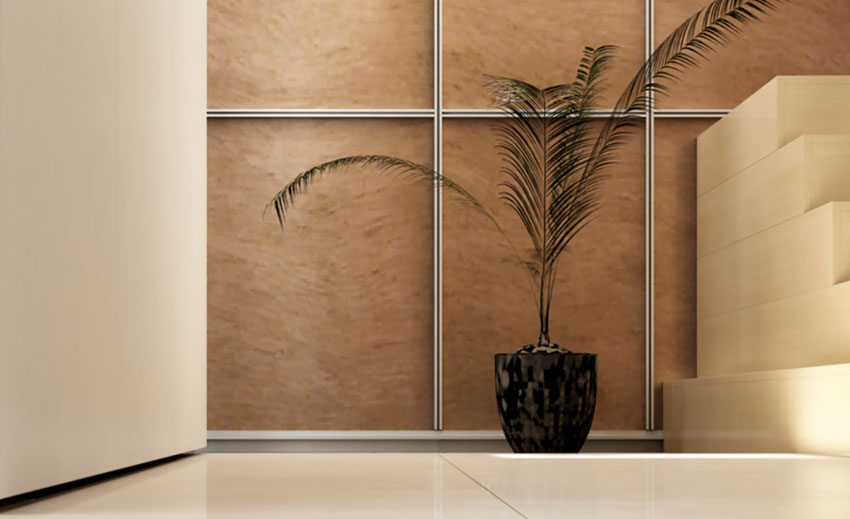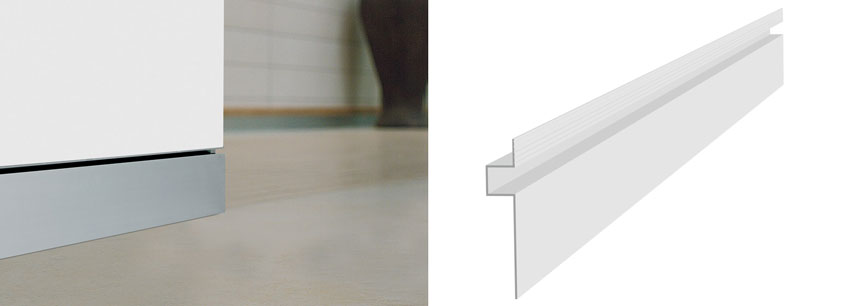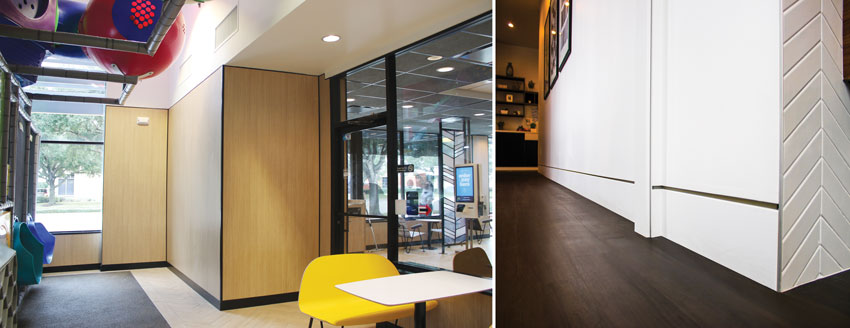What’s New in Retail and Hospitality Design?
Elevator Renovation
Many retail and virtually all hospitality buildings include elevators either for convenience or to meet accessibility requirements. From a design standpoint, the cabs of these elevators should not be overlooked since it is a very real part of the user experience of many guests or customers. If addressed properly, they can be an integral part of the interior design of a facility with the integrity and durability to hold up to heavy use from people, carts, etc.
As an elevator is used over time, the cab interiors can get damaged, especially if they are used for both passengers and freight. Even under the best circumstances, dollies, bell carts, suitcases, freight, and furniture can gouge and scuff walls inside the elevator. The better way to address this potential damage is with protective wall panels and handrails that can resist these forces and keep the inside of the cab looking good.
In addition to needing protection, it is possible for the cab to simply look outdated over time just like any other interior scheme. Further, the lighting in an elevator cab needs to be adequate and maintained so that it doesn’t provide a dim, unattractive experience. Given these concerns, many designers are turning to preconfigured elevator cab renovation packages to breathe new life back into existing elevators or even starting out with them in new elevator cabs. Such packages can include new wall panels, ceiling grids and panels, handrails, and lighting. As a package, they can be coordinated to meet the demands for durability and the interior design scheme that is sought.
One critical aspect to bear in mind is that interior cab renovations often cannot be allowed to take the cab out of service for any extended period of time. Taking a cab down for renovation increases the potential for longer wait times, as the same number of passengers have fewer cabs to ride in. Ideally, then, cab renovation materials and processes should be designed to cut downtime to a bare minimum. Toward that end, modular renovation packages can be specified that allow for simple and easy installation.

Photo courtesy of Inpro
Elevator cabs are part of interiors too. Using modular cab interior packages can provide a quick means to upgrade the interiors and provide protection against damage.
Innovative, Modern Wall Surfaces
Among the first surfaces that people experience in an interior space are the walls. They can be as simple and understated as white painted gypsum board or as elaborate and detailed as a designer’s imagination allows. All the while, they need to be easy to maintain and clean over the life of the building.
The trend in modern designs for retail and hospitality settings includes minimalist lines and the intentional absence of traditional moldings for doors, windows, ceilings and base conditions. With this in mind, many interior designs lean toward a simpler, more elegant wall-surface solution with a clean, modern look. Others select certain walls to feature with added detailing and trim to create a total appearance. Achieving any of these looks typically involves panels, of some sort such as gypsum board or other rigid materials with reveals or trim around the edges. That trim can be metal, wood, or other suitable choices to frame and accentuate a wall surface while protecting and aligning the panels.
Aluminum Interior Trim
One increasingly popular method of dealing with finish panels on wall surfaces is to use manufactured trim pieces made from aluminum extrusions. Standard products are readily available that are designed to be used with 5⁄8-inch-thick drywall to provide continuous edge protection. Similarly, aluminum trim can be used in conjunction with wrapped surface finishes, such as fabric or vinyl wall coverings. Such trim pieces are available in a variety of traditional, contemporary, and modern looks to create subdued, elegant aesthetics or emphatic three-dimensional appearances. Since aluminum is highly durable, recyclable, lightweight, and noncombustible, it is a popular and logical choice for interior trim of this type. Its strength helps provide some wall protection when used for corners and other areas that need some reinforcement. In that sense, it is a good example of a well-known material that can be used in innovative ways for interior designs.
Of course, the color of the trim is an important design consideration, regardless of the location. Fortunately, there are many options beyond the standard mill-finish aluminum coloring. Extruded aluminum trim can be specified to be finished with a paint primer only ready to receive final finish coats in the field of virtually any color. Alternatively, it can be specified as prefinished in the factory reducing the onsite labor needs. The standard prefinished choices vary by manufacturer but typically include durable powder-coat paint, conventional wet-paint coatings, or anodized aluminum in standard colors, such as clear, champagne, bronzes and black. At least one manufacturer can provide custom pattern matching on the aluminum to include logos, match wood panels or stone walls, or create a wood grain or even denim look. With this variety of choices, the trim can appear to blend in with the adjacent wall panels, or it can be used to highlight all or some of the visual lines it creates. This flexibility using familiar and long-lasting finish options means that both the design and the performance level can be controlled.

Photo courtesy of XtremeInterior by Tamlyn
Aluminum trim can be used very effectively to create interior wall designs that are durable and make strong visual statements.
In addition to standard trim products, custom profile shapes can be made quite affordably to accommodate not only particular styles but also to hold other materials such as glass, tile, panels, etc. in a variety of thicknesses. Some manufacturers offer customized service and designs to architects and will readily meet to discuss design ideas and solutions. They point out that if the trim profile can be drawn in a single line, it can probably be extruded. This service is not only centered on aesthetic issues but also on technical and performance issues of the trim related to its ability to perform and hold up over time. Dana Madden, product director with XtremeInterior by Tamlyn, reinforces this customized approach by saying, “The magic of aluminum is that the possibilities are endless. Everything from design, shape, size, color, finish, and temper to fit can be adjusted to meet the needs of each client/architect/designer.”
The unique design possibilities of using aluminum interior trim can create clean lines, shadow lines, or reveals that make a wall surface stand out as part of an interior space. It is also readily possible to create rounded corners, smooth transitions, or other shapes that enhance the overall design of the space in ways that wouldn’t be possible with traditional wall surfacing techniques.

Images courtesy of XtremeInterior by Tamlyn
Aluminum trim systems can create simple but stunning profiles for innovative wall surfaces. As shown here, they can provide flush base profiles that avoid interfering with furnishings yet still serve as protection for the lower edge of drywall.
Dan Brunn of Dan Brunn Architecture (DBA), Los Angeles, has worked with manufacturers on designs of this type and created some very successful interiors in the process. He notes, “Aluminum trim offers the perfect finishing solution for all of our modern building needs. I love the unique extrusions to create light pockets and that perfect reveal.” Designers like Brunn have also found that to be fully successful, a design needs to address all of the conditions and details of wall surfaces. That includes the wall base, corners, top edge, and any openings or variations. In that regard, they find that working with a single manufacturer who can provide all of the needed trim pieces in a coordinated system is a big key to success. Maybe just as importantly, being able to work out the details using a consistent and proven system means that innovation is possible without taking on undue design risk.
Retail and Hospitality Applications
Places that need to achieve good interior looks with a lot of durability, like retail and hospitality settings, quickly see the benefit of using extruded aluminum trim in conjunction with prefinished wall panels or site-finished gypsum board. For example, many fast-food restaurants often go through cycles of renovating and updating their locations to remain appealing to customers and competitive in the marketplace. The current trend among many of them, such as McDonald’s, Dunkin Donuts, Burger King, and others, is to move to a more sleek and modern motif, replacing some prior looks that are more visually cluttered and outdated in appearance. In the process, many are using prefinished wall panels with a selected wood grain or color as their primary wall surface. Then they are incorporating aluminum trim in coordinated finishes to provide durable corner and wall base conditions. They may also use aluminum trim pieces to create intentional reveals in the walls between the panels or at interior corners. Along the ceiling line, some incorporate an extruded aluminum trim piece that acts as a ceiling molding to complete the overall look and design intent.
Hospitality settings similarly require durability but may have a different aesthetic in mind. In these cases, extruded aluminum trim may be used with gypsum board to create defining lines along a wall surface or at the intersection of wall elements. Reveals are particularly popular in that regard and can be provided in a thin, minimalistic manner to simply reinforce vertical or horizontal lines, or to create an artistic accent on a wall. For a bolder, more three-dimensional profile, two-piece assemblies are available that allow a squared, rounded, or oblong shape to be inserted into a reveal that protrudes past the wall surface and creates a different shadow line and overall look.
Overall, extruded aluminum trim is an easy-to-install, logical solution for many interiors. It can be used as a stand-alone finished product or specified to have an edging to allow gypsum board tape and finishing compound that smoothly resolves into the surface of adjoining gypsum board. Either way, the designer is in control of the look, and with so many options of profiles, sizes, and colors available, the end result can enhance retail and hospitality settings of all types.

Photos courtesy of XtremeInterior by Tamlyn
Aluminum trim is shown here as used in fast-food restaurants (left) to provide clean, durable, and contemporary edging to wall panels. In hospitality settings (right), they can be used to blend with wall and base materials to establish an upscale, elegant look.









